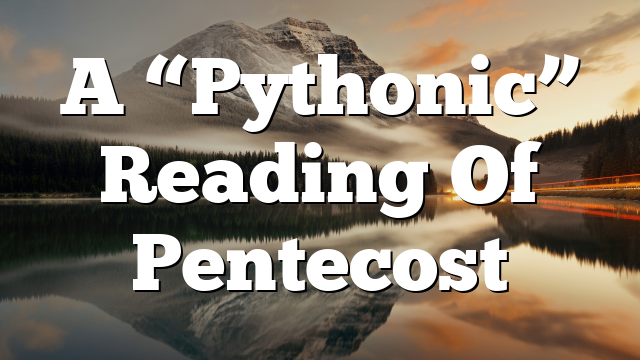Click to join the conversation with over 500,000 Pentecostal believers and scholars
Click to get our FREE MOBILE APP and stay connected
| PentecostalTheology.com



Pneuma 33 (2011) 59-62
“And Now for Something Completely Different”:
A “Pythonic” Reading of Pentecost?
Blaine Charette Northwest University, Kirkland, Washington
blaine.charette@northwestu.edu
Abstract
Jack Levison’s discussion of spirit filling in Acts, although highly inventive, ultimately lacks cogency. His attempt to view the episode of the slave girl possessed of a “pythonic spirit” as paradigmatic for understanding the experience of the believers at Pentecost fails because of a misreading of the Acts 16 text and a misrepresentation of Luke’s interests with respect to the Hellenistic religious context of early Christianity. Levison’s reading of the Pentecost event is similarly flawed by the importation of unwarranted parallels from the Hellenistic religious environment. Positively, the study points to the need for further research on the subject of ecstasy in the New Testament.
Keywords
spirit filling, ecstasy, inspiration, pythonic spiritism
Jack Levison’s discussion of spirit filling, ecstasy, and inspiration in the Book of Acts (Filled with the Spirit, Part III, Chapter 3: “Filled with the Spirit and the Book of Acts”) is without question innovative and stimulating.* Even though one might disagree with the particular manner in which he frames the discussion or criticize his interpretation of specific passages, one cannot help but be impressed by the creativity with which he approaches his subject. By referencing the famous tagline of the Monty Python troupe in the title of this review, I am not suggesting that Levison’s discussion of the Pentecost
* Troughout this review I have followed Levison’s practice of not capitalizing the word spirit. Levison means no disrespect by this decision; rather, the stylistic choice simply draws attention to the wide range of meaning behind the Hebrew ruach and the Greek pneuma, espe- cially in view of the fact that on occasion it is difficult to determine whether the biblical text refers to the human spirit or the divine spirit.
© Koninklijke Brill NV, Leiden, 2011 DOI: 10.1163/157007411X554703
1
60
B. Charette / Pneuma 33 (2011) 59-62
event is the stuff of absurdist parody (it is much too serious a work for such frivolous dismissal), yet at the same time his inventive approach to the Acts narrative in which he is at times too eager to embrace the novel interpretation results in conclusions that often lack cogency.
Levison opens his discussion with the provocative observation that the brief episode of the slave girl possessed of a “pythonic spirit” in Acts 16 helps the reader “to distinguish the hues of Luke’s conception of being filled by the holy spirit” and offers an “unvarnished glimpse of inspiration” (318). Trough this narrative the reader can discern “important dimensions of Luke’s percep- tion of inspiration” (322) to such an extent that one can see “an enticing analogy between the slave-girl of Acts 16 and the believers at Pentecost” (323). Levison is content to draw this comparison between the slave girl’s inspiration and that of the believers at Pentecost because of the way in which he chooses to read the narrative at Acts 16:16-19.
First, Levison maintains that, whereas the form of inspiration represented by the slave girl was roundly rejected by Jews, such is not the case with Luke. In the Acts narrative there is none of the harsh criticism one might expect to find in Jewish or Roman responses to pythonic spiritism. In Luke’s account the slave girl is not seen as a threat; she does not stand in opposition to the Pauline mission and thus there is no censure of the woman. Paul eventually commands the spirit to leave the girl not because she represents an evil that must be opposed but rather because she has become annoying through her persistent speaking: “Te slave-girl’s prophesying is permissible until, oddly enough, it grates on Paul’s nerves” (322). Tis is certainly one way to read the narrative, but it is not conistent with the way in which Luke elsewhere pres- ents the interface between Christian understandings of spirit and power and those that obtained in Hellenistic religion. Luke is committed to define Christian beliefs and practices over against those of paganism (consider the many critiques of “magical” understandings of power found in Acts); he would not use a pagan model as a descriptive device to assist his readers bet- ter to understand Christian conceptions of spirit filling and inspiration. A better reading of the text recognizes that Luke critiques pythonic spirit- ism through his usual method of presenting the episode in the form of a comic narrative (one can compare the sons of Sceva episode at 19:13-17). It is true that Paul does not view the slave girl’s utterances as necessarily menac- ing, and he only exorcizes the spirit in a moment of irritation after his patience is exhausted. Yet, far from suggesting Luke’s tacit acceptance of the phenomenology represented in the slave girl, this demonstrates just how dis- missive Luke is of the phenomenon. It is Luke’s robust confidence in the
2
B. Charette / Pneuma 33 (2011) 59-62
61
power of God’s spirit that leads him (and Paul within the narrative) not to be overly concerned with the girl’s inspiration, but in no way does Luke take up her inspiration as a hermeneutical lens through which one can better under- stand the dynamics of being filled with the spirit.
Second, Levison maintains that Luke takes this positive approach to the inspiration of the slave girl because through her inspiration she operates in alliance with the work of God: “Tese men are slaves of the Most High God, who proclaim to you a way of salvation” (16:17). According to Levison, this is “arguably, and surprisingly, the most concise encapsulation of the message of salvation in Acts; it is an accurate précis of key themes from Luke-Acts” (321). He further notes that the slave girl is “more uniquely Lucan than the Lucan Peter!” (321). Leaving aside the fact that little, if anything, in the words of the girl reflects the Acts kerygma, is it true to say that “a mere slave- girl filled by a pythonic spirit divines the truth so accurately” (324)? Her exact words, which might in part account for Paul’s mounting frustration, are, “these men . . . proclaim to you a way of salvation ( ὁδὸν σωτηρίας).” Te absence of the definite article before “way” is probably significant. Elsewhere in Acts when “way” is used as a designation for the Christian movement and belief system, it is always identified as “the way” (cf. 9:2; 18:25, 26; 19:9, 23; 22:4; 24:14, 22). Te words of the girl could be interpreted as a direct chal- lenge to Peter’s assertion earlier in Acts that “there is salvation in no one else, for there is no other name under heaven given among people by which we must be saved” (4:12). If this is the case, then far from operating in alliance with the work of God her utterance aligns her more with the Jewish false prophet Bar-jesus who makes crooked “the straight ways” of the Lord (13:10). Once again the text provides no support for reading the inspiration of the slave girl in a positive manner, let alone for advancing her case as a paradigm for understanding Christian inspiration.
Levison is drawn to the case of the slave girl because it provides a means of exploring the nature of inspiration at Pentecost, especially with reference to the dual and apparently incompatible elements on that occasion of the uncontrol- lable (the condition of ecstasy) and the comprehensible (the proclamation of good news). What he sees as paradigmatic in the experience of the girl is that although her mind is disengaged (that is, she is in a state of ecstasy), the pythonic spirit speaking through her gets the message right (which is to say, it lucidly proclaims the way of salvation). Is this a fair description of what occurs at Pentecost? Without disputing the presence of an ecstatic element in the Pen- tecost event, it is questionable whether Levision’s description of the ecstatic dimension to the Pentecost experience is correct.
3
62
B. Charette / Pneuma 33 (2011) 59-62
According to Levison, when Luke adopts the language of filling with the spirit, he “situates the experience of Pentecost in a robust cultural setting that saw filling with a pneuma as the precipitating factor in enthusiasm” (328). Once again his reading is characterized by special pleading and allows for a better explanation. Luke’s description of tongues as of fire resting on the believers (2:3) is far removed from the parallels Levison draws concerning persons possessed of a pneuma who are ignited and inflamed as they enter an ecstatic state over which they have no control. Similarly, he makes too much of the charge leveled against the believers that they “are filled with new wine” (2:13). Within the narrative it is important that this opinion of certain returned Diaspora Jews in the audience finds expression, but only so that it can be corrected by Peter. It is not the case that Luke is intentionally portray- ing the disciples as having a fiery, drunken demeanor and thus evincing a “form of inspiration that rivals Delphi and ranks Jesus’ followers with inspired sibyls” (335). If it were Luke’s intention to demonstrate these associations, he would have written a very different narrative.
Te strongest and most convincing part of Levison’s discussion is found in the final sections of the chapter treating “speaking in tongues” in Acts and 1 Corinthians and the spirit-inspired interpretation of Scripture. Te focus of these sections is on the comprehensibility of spirit-inspired speech that Levi- son views in a counterpart relationship to the ecstatic dimension of spirit fill- ing. In reading this section one senses that Levison’s overall argument could be more convincing if he were to develop a definition of ecstasy that owed less to Hellenistic conceptions and more to the understanding that Luke (and Paul) are seeking to promote. For example, he notes that for Luke, speaking in (other) tongues is associated with comprehensible praise and prophecy and that for Paul the mind need not be unproductive when one prays or speaks in a tongue. Both authors seem to favor a controlled comprehensible ecstasy that is distinct from the experiences commonplace in the religious environ- ment outside of the Christian community. Greater attention to such evidence within the text would have resulted in a more convincing discussion. Levi- son’s novel approach to spirit filling in Acts is not without merit, especially with respect to drawing attention to areas where further research is needed, yet as it stands it is too idiosyncratic to occasion a reassessment of the topic.
4




Most Talked About Today